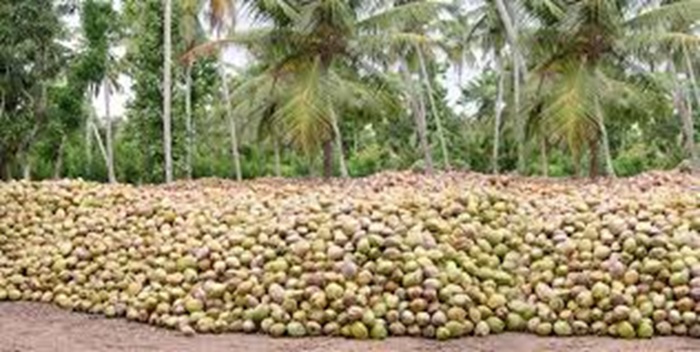
Minister of Plantation and Community Infrastructure Samantha Vidyaratna says the program titled “Kapruk Saviya: A Steady Strength for the Nation” is being implemented with the expectation of increasing Sri Lanka’s coconut revenue to USD 1,500 million by the year 2030.
Minister Samantha Vidyaratna said the “Kap Thuru Saviya” project will be launched on 02nd September, coinciding with World Coconut Day.
He further said that alongside this celebration, a new phase of development will begin in the Northern Coconut Triangle under the leadership of President Anura Kumara Dissanayake, and the launch will take place in Pudukuduirippu.
The minister went on to note that in 2025, 16,000 acres of coconut will be cultivated in the North, developing the Jaffna, Mullaitivu, and Mannar triangle as the Northern Coconut Triangle.
In 2026, another 16,000 acres will be cultivated, and in 2027, 8,000 acres. By 2027, the North will have 50,000 acres of coconut cultivation. Plans are also in place to cultivate 20,000 acres in other regions. Coconut seedlings will be provided under a subsidy scheme at Rs. 150 per plant, he said.
Minister Samantha Vidyaratna further revealed that as part of the home garden coconut cultivation program, 500,000 seedlings will be distributed, two per household, stating that the aim is to implement coconut cultivation under a targeted policy.
He made the remarks yesterday (25) during a media briefing held at the Government Information Department.
“Although coconut, a major plantation crop, has earned significant export income for the country, in recent times, the harvest has not even been sufficient for domestic consumption. Coconut prices rose, causing hardship for the public. This situation arose due to the lack of proper attention and strategic planning in the coconut cultivation sector. The current government has developed strategic plans for the coconut and other plantation sectors. Accordingly, a five-year strategic plan has been formulated in collaboration with UNIDO for the coconut sector.
Stating that plans are in place to increase the coconut harvest and revenue by 2030, he revealed that in 2024, the coconut harvest was 2,754 million nuts, while the annual requirement is 3,000 million nuts.
Pointing out that by 2030, this amount will not be sufficient, he said the plan is to raise the harvest to 4,200 million nuts.
Minister of Plantation and Community Infrastructure Samantha Vidyaratna elaborated further on the steps being taken by the government.
Due to the shortage in 2024, approximately 200 million coconuts had to be imported through cabinet approval to meet industrial and consumption needs.
This results in dollars flowing out of the country. The recent economic crisis affected many industries, including the coconut industry. To revive these sectors, work must be done under a proper plan, hence the five-year strategy.
Last year, the coconut industry earned USD 854 million. The goal is to increase this to USD 1,500 million by 2030. In the past, coconut trees were not properly cared for as the water supply and fertilizer application were inadequate. For the first time, farmers have been provided with subsidized coconut fertilizer.
Discussions with Russia led to the acquisition of MOP fertilizer, which needs to be blended with two other types to convert it into coconut fertilizer. Currently, coconut fertilizer priced at around Rs. 9,500 per bag in the market is being provided at a subsidized rate of Rs. 4,000.
For the past four to five years, even government coconut plantations have not received fertilizer. Unlike other crops, coconut does not yield immediately after fertilization, it takes about one and a half years. Therefore, the current coconut crisis is expected to persist for a while. Plans are in place to provide continuous fertilizer subsidies and ensure proper water supply.
According to the Coconut Research Institute, a side-bearing tree can yield 45–55 nuts. Other countries achieve higher yields. With proper fertilization, irrigation, and pest control, Sri Lankan coconut trees could potentially yield up to 80 nuts.
This special project has been named “Kap Thuru Saviya.” It will be launched on September 2nd, coinciding with World Coconut Day. Alongside this celebration, a new phase of development will begin in the Northern Coconut Triangle. Under the leadership of President Anura Kumara Dissanayake, the launch will take place in Pudukuduirippu. In 2025, 16,000 acres of coconut will be cultivated in the North, developing the Jaffna, Mullaitivu, and Mannar triangle as the Northern Coconut Triangle.
In 2026, another 16,000 acres will be cultivated, and in 2027, 8,000 acres. By 2027, the North will have 50,000 acres of coconut cultivation. Plans are also in place to cultivate 20,000 acres in other regions. Coconut seedlings will be provided under a subsidy scheme at Rs. 150 per plant.
As part of the home garden coconut cultivation program, 500,000 seedlings will be distributed, two per household. The aim is to implement coconut cultivation under a targeted policy.
Next year, plantation crops are expected to generate USD 6 billion in revenue. A program to rehabilitate abandoned coconut and rubber estates will begin next year. Steps will also be taken to promote king coconut cultivation within the coconut industry. (Newswire)
